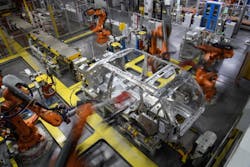With all the advances that have been made on the robotics front over the past several years—from easier programmability and the incorporation of vision to the rise of collaborative robots—the calls for massive surge in robot purchases and deployments have been getting louder and louder. Though data has been showing a steady increase in robot purchases year over year, it seems as if 2016 was the turning point year.
According to report from the Robotics Industries Association (RIA), the North American robotics market broke all-time records for orders and shipments in 2016. During the year, 34,606 robots valued at approximately $1.9 billion were ordered in North America, representing growth of 10 percent in units ordered compared to 2015, said the RIA. Units shipped to North American customers also grew by 10 percent, with 30,875 robots valued at $1.8 billion shipped in 2016.
As usual, the automotive industry remains the largest user of robotics. Orders from the automotive industry grew 17 percent in 2016, with shipments into the automotive market having grown by 25 percent relative to 2015.
Though the automotive industry dominated in its purchase of robots, other industrial verticals played a significant role in boosting overall robot orders. The RIA said that orders for robots increased by 61 percent in assembly applications and by 24 percent in spot welding. Also, the food and consumer goods industry increased orders for robots by 32 percent in 2016, with robots being deployed for a variety of functions, such as improving food safety, performing repetitive primary packaging tasks like bin picking, tray loading and bottle handling, and assisting with secondary packaging tasks such as case packing, bundling, bagging and palletizing.
Read more about robotics and automation technology trends in the pharmaceutical industries.
Looking beyond the overall numbers supporting the growth of robotics, Universal Robots—which is known for its collaborative robots—says it grew by 62 percent in 2016.
Jürgen von Hollen, president of Universal Robots, credits the company’s growth to the inherent advantage collaborative robots have in when it comes to being applied in companies of all sizes. “Our technology has been an enabler for all companies—not just large corporations—to integrate automation into their production processes,” he said.
Continued growth for Universal Robots is expected by von Hollen. He predicts that revenue will increase by 50 percent or more in 2017. “Scaling the business to continue to deliver growth year-after-year is a key priority. Compared to 2015, we have more than tripled our investments in 2016, especially in R&D. Equally important has been our continued investment of more than 50 percent into the Universal Robots staff in 2016 to extend our capability, know-how and reach globally.”
Universal Robots doubled its global presence in 2016, growing from having a presence in 5 countries in 2015 to 11 countries today. The company now has offices in the U.S., Spain, Germany, Italy, Czech Republic, China, Singapore, India, Japan, Taiwan and South Korea. The company’s distribution channel covers more than 50 countries.
Leaders relevant to this article:


